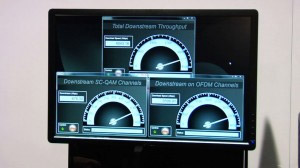By Madeleine Ewins, Product Manager Intern, Broadband & Connectivity Group at Broadcom
LAS VEGAS — Truth be told, the big headlines from this week’s International Consumer Electronics Show likely won’t focus on Gigabit speed broadband in the home.
 “As we begin to use the Internet and other services more, the pipe going into the home needs to get bigger and bigger,” said Jay Kirchoff, vice president of marketing in the Broadband & Connectivity Group at Broadcom.
“As we begin to use the Internet and other services more, the pipe going into the home needs to get bigger and bigger,” said Jay Kirchoff, vice president of marketing in the Broadband & Connectivity Group at Broadcom.
“A couple of years ago you probably had two or three devices in your home that consumed the Internet,” Kirchoff said. “Next year, it’s probably going to be up to 50 devices in the home that will want Internet access.”
DOCSIS 3.1 Demo CES 2015
Multi-gigabit-per-second networks to the home aren’t all that common in the United States, outside of cities that are serviced by Google Fiber. Typically, a home connection delivers broadband speeds in the 20 Mbps range with costly higher-tier packages topping out at 505 Mbps.
In the past, the options for getting close to one gigabit-per-second network speeds on cable networks at home were few and far between, mainly due to the cost of upgrading the infrastructure.
But that’s starting to change with the recent rollout of a standard dubbed DOCSIS 3.1, which is set to enable multi-gigabit speeds via cable modems in consumers’ homes. Broadcom is the first silicon vendor to offer up a cable modem system-on-a-chip that’s DOCSIS 3.1-ready.
So what does this mean for the everyday cable consumer?
Generally, it means more smartphones, tablets and laptops can happily coexist on the same home broadband network without any slowdown in performance, given that network speeds above 1 Gbps can support more devices connected on a single home network with faster, more reliable service.
On the operator side, the cable modem-on-a-chip makes it easier and less costly for broadband service providers to implement gigabit speeds.
In the video below, Kirchoff demonstrates how the new BCM93390 manages download speeds of more than 4 Gbps.






